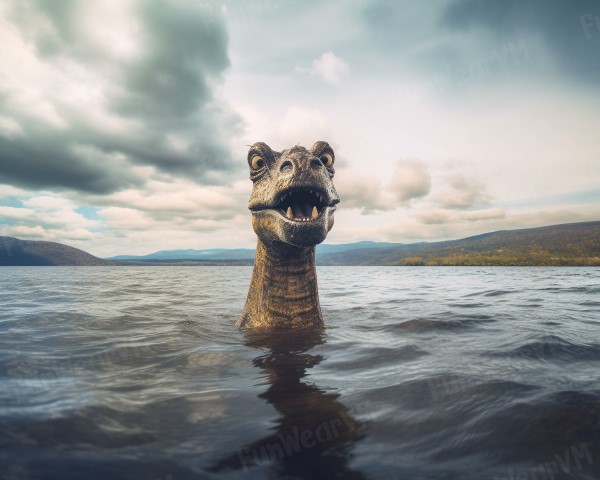Cadborosaurus, or Caddy for short is a legendary sea creature that has been reported by hundreds of witnesses along the Pacific Coast of North America, from California to Alaska. Some people believe it is a living dinosaur, a relic from the age of plesiosaurs. Others think it is a giant oarfish, a basking shark, or a sea lion.

History of Cadborosaurus
The name Cadborosaurus comes from Cadboro Bay in Greater Victoria, British Columbia, where many sightings have occurred. The name also combines the Greek root word “saurus”, meaning lizard or reptile. The first recorded sighting of Caddy dates back to 1933, when a fisherman named William Hagelund claimed to have seen a 30-foot-long creature with a horse-like head and a long neck near De Courcy Island. He described it as having “a mane of coarse hair” and “a pair of small flippers”. He also said it had “a large tail which seemed to be divided into two parts”. Hagelund later wrote a book about his encounter, titled “Whalers No More”.
Since then, there have been over 300 reported sightings of Caddy by various witnesses, including fishermen, sailors, police officers, scientists, and tourists. Some of the most notable sightings include:
- In 1943, two police officers saw a “huge sea serpent with a horse-like head” in Georgia Strait. They later realized it was a bull sea lion leading a herd of six sea lions.
- In 1937, fishermen found a strange carcass inside the stomach of a whale near Naden Harbour. The carcass was about 12 feet long and had a camel-like head, flippers, and scales. It was photographed and sent to the BC Provincial Museum for analysis. Some experts identified it as a fetal bailing whale, while others suggested it was a new species of marine animal.
- In 1968, Robert Swanson filmed an unidentified creature in Active Pass. The footage showed a long, dark shape moving through the water with several humps. Swanson claimed it was Caddy and offered $50,000 to anyone who could prove otherwise.
- In 1989, Kelly Nash took a photograph of what appeared to be Caddy’s head and neck emerging from the water near Telegraph Cove. The photo was examined by several experts, who gave conflicting opinions on its authenticity and identity.
- In 2009, Jason Walton captured an image of Caddy on his sonar device while fishing near Discovery Island. The image showed a large object with a curved shape and several protrusions. Walton estimated it was about 25 feet long and 3 feet wide.
Description of Cadborosaurus
Cadborosaurus has been described in various ways by different witnesses, but there are some common features that emerge from most accounts. These include:
- A horse-like or camel-like head with large eyes and ears
- A long neck that can bend and twist
- A slender body with scales or smooth skin
- A pair of front flippers and either a pair of hind flippers or a large fan-like tail
- A length ranging from 10 to 50 feet
- A color ranging from brown to black to green
- A behavior that is shy and curious
Evidence for Cadborosaurus
The main evidence for Cadborosaurus consists of eyewitness testimonies, photographs, videos, sonar images, and carcasses. However, none of these are conclusive or widely accepted by mainstream science. Some of the problems with the evidence include:
- Eyewitness testimonies are unreliable and prone to errors and exaggerations
- Photographs and videos are often blurry, grainy, or ambiguous
- Sonar images are difficult to interpret and can be affected by interference or glitches
- Carcasses are rare and often decomposed or mutilated
Possible Explanations for Cadborosaurus
There are several possible explanations for Cadborosaurus that do not involve a new or unknown species of animal. These include:
- Sea lions: Sea lions can form groups that look like one long creature when they swim together. They also have horse-like heads and can make loud noises.
- Basking sharks: Basking sharks are large fish that can grow up to 40 feet long. They have elongated bodies and dorsal fins that can create humps when they surface. When they die, their carcasses can lose their jaws and gills, leaving behind a skull that resembles Caddy’s head.
- Oarfish: Oarfish are rare fish that can reach up to 56 feet long. They have slender bodies and bright colors that can reflect light. They also have crest-like fins on their heads that can look like ears or horns.
- Plesiosaurs: Plesiosaurs were marine reptiles that lived during the Mesozoic era. They had long necks, flippers, and tails that match Caddy’s description. However, there is no evidence that they survived the mass extinction event that wiped out most dinosaurs.
Conclusion
Cadborosaurus is a fascinating mystery that has captivated many people for decades. Whether it is a real sea serpent or a mythological creature, it reflects our curiosity and imagination about the wonders of nature. If you ever visit the Pacific Coast of North America, keep your eyes open for Caddy. You might be lucky enough to catch a glimpse of this elusive legend.
References:
